
Create AI videos with 230+ avatars in 140+ languages.
The rapid adoption of AI video is transforming many industries, with L&D being no exception. In this report, you can discover the latest trends and insights into the role of video in training, as shared by 102 Synthesia users in the L&D space.
To provide additional context, the report also includes commentary from various industry experts.
How is video used in L&D today?
It is widely known that learners are fond of video, but what is the perspective of L&D professionals on its significance? This section provides information on the frequency of video usage, popular topics, and the main reasons for choosing it as a training format in 2023.
Stat 1: 98% of respondents think that video is important for their organization's L&D strategy.
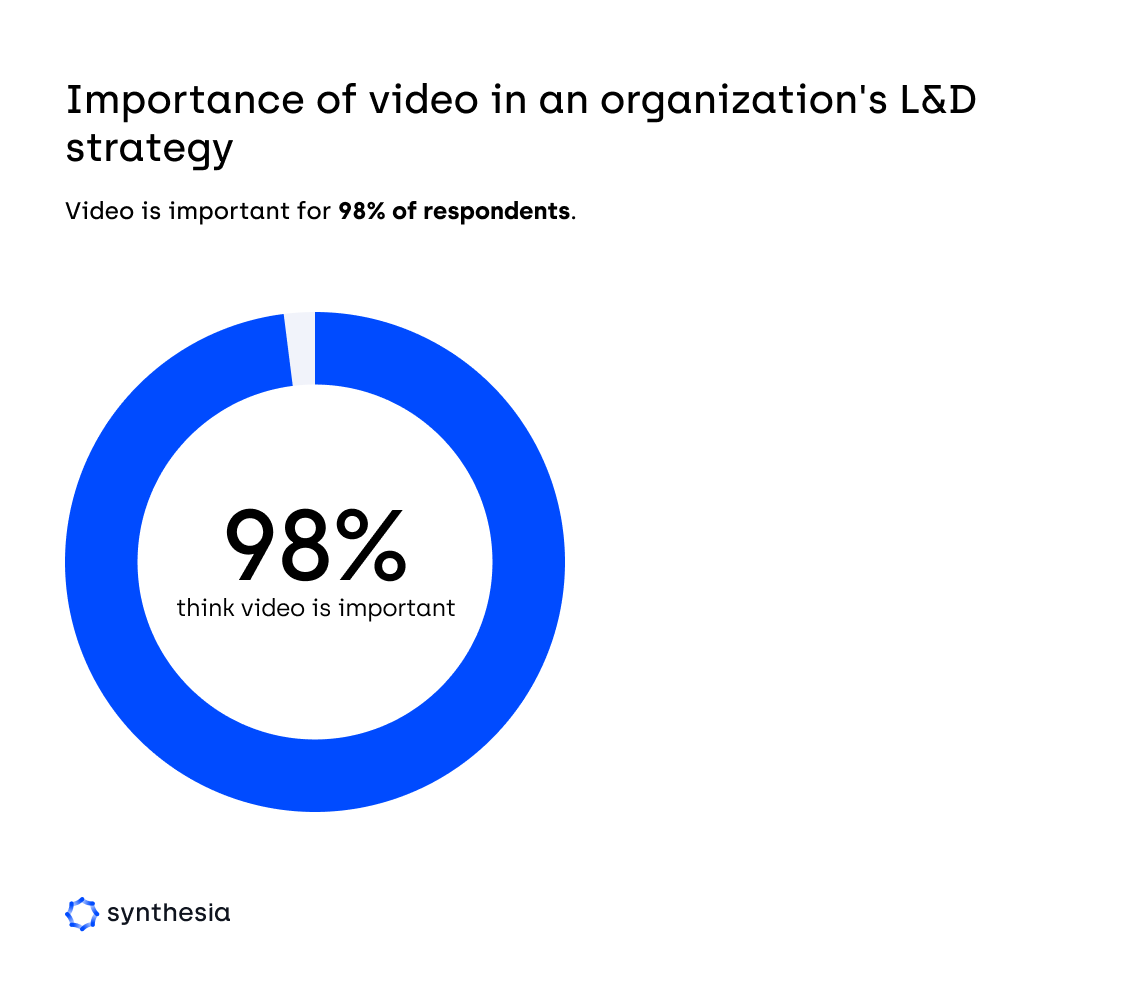
Stat 2: In 2023, the most popular training content delivery formats are training videos, slide presentations and eLearning.

Stat 3: The most popular training video types in 2023 are: presenter-led, screencast, animated.
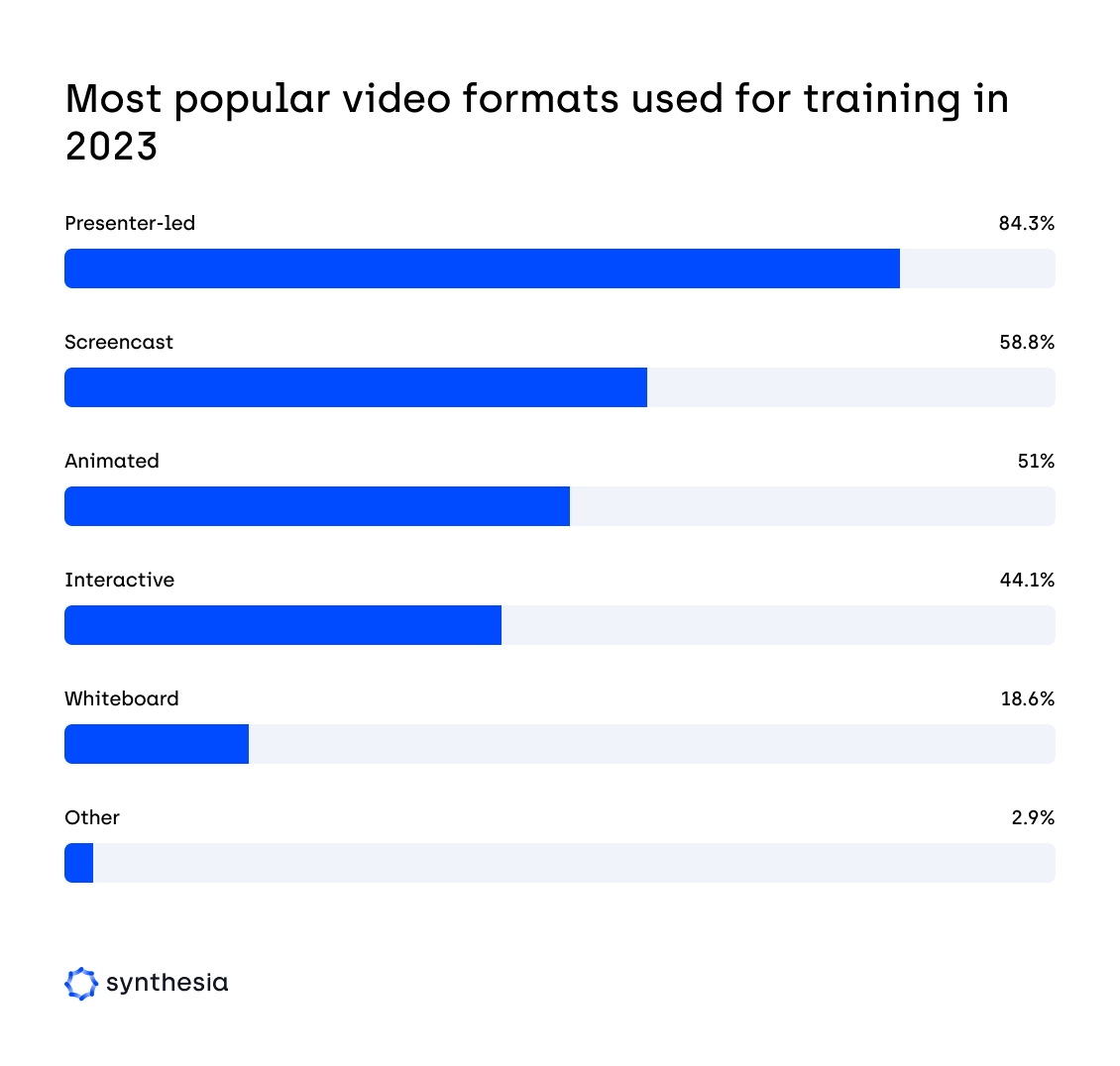
Stat 4: Top 3 training video topics in 2023: technical training, employee development & employee onboarding.

Stat 5: The top 3 reasons for using video in L&D are: microlearning, more on-demand learning content/SDL, content in other languages.
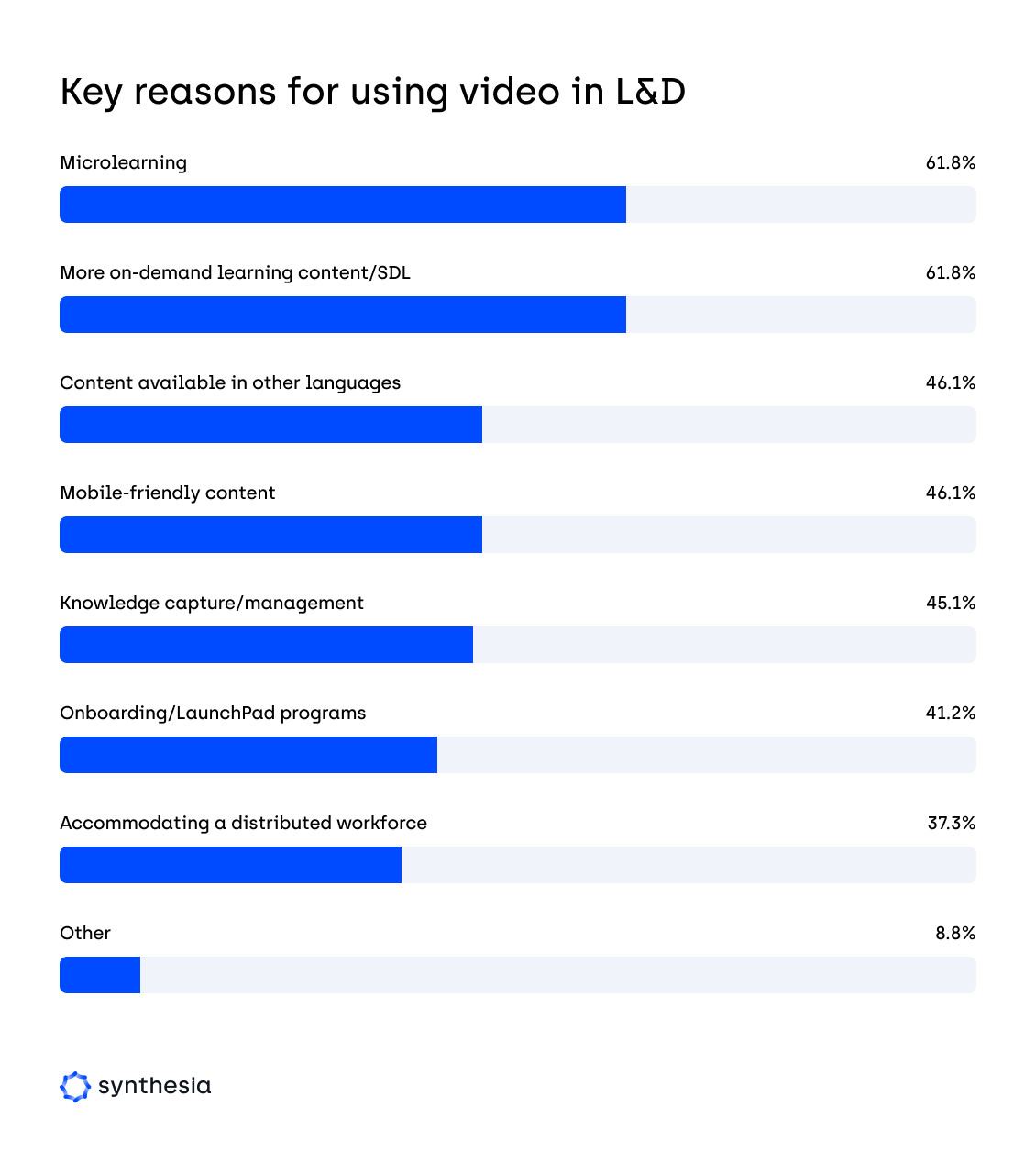
Beyond numbers: what do the experts think?
To add, resource allocation plays a role in the popularity of videos in L&D. Repeatability of videos also means ROI for the business. The more the videos are played, the higher the ROI because it means we get to play it to more audience even all at the same time, without asking for a physical facilitator to travel from one site to the next, with no issues on schedules. - Jeannette Readbad, L&D Head
I would also add a couple more possible obstacles when it comes to video- searchability and the lack of uniform access to technology especially when delivering video for consumption of mobile devices… So we need to make sure this is factored into the design. - Ajay Jacob, L&D Manager
Microlearning being named the top reason people include video in their L&D strategy implies they’re thinking about content that tackles specific problems and helps solve them in moments of need. - Gary Stringer, Senior Content Marketing Manager
Challenges of video creation in L&D
AI has made video production much easier, but that wasn’t always the case. Traditional video production has many limitations, and here's how L&D teams approached video creation before leveraging AI.
Stat 6: 16% of respondents have not made videos before using AI because it's too time-consuming, they lack specialized skills, and it's too costly.
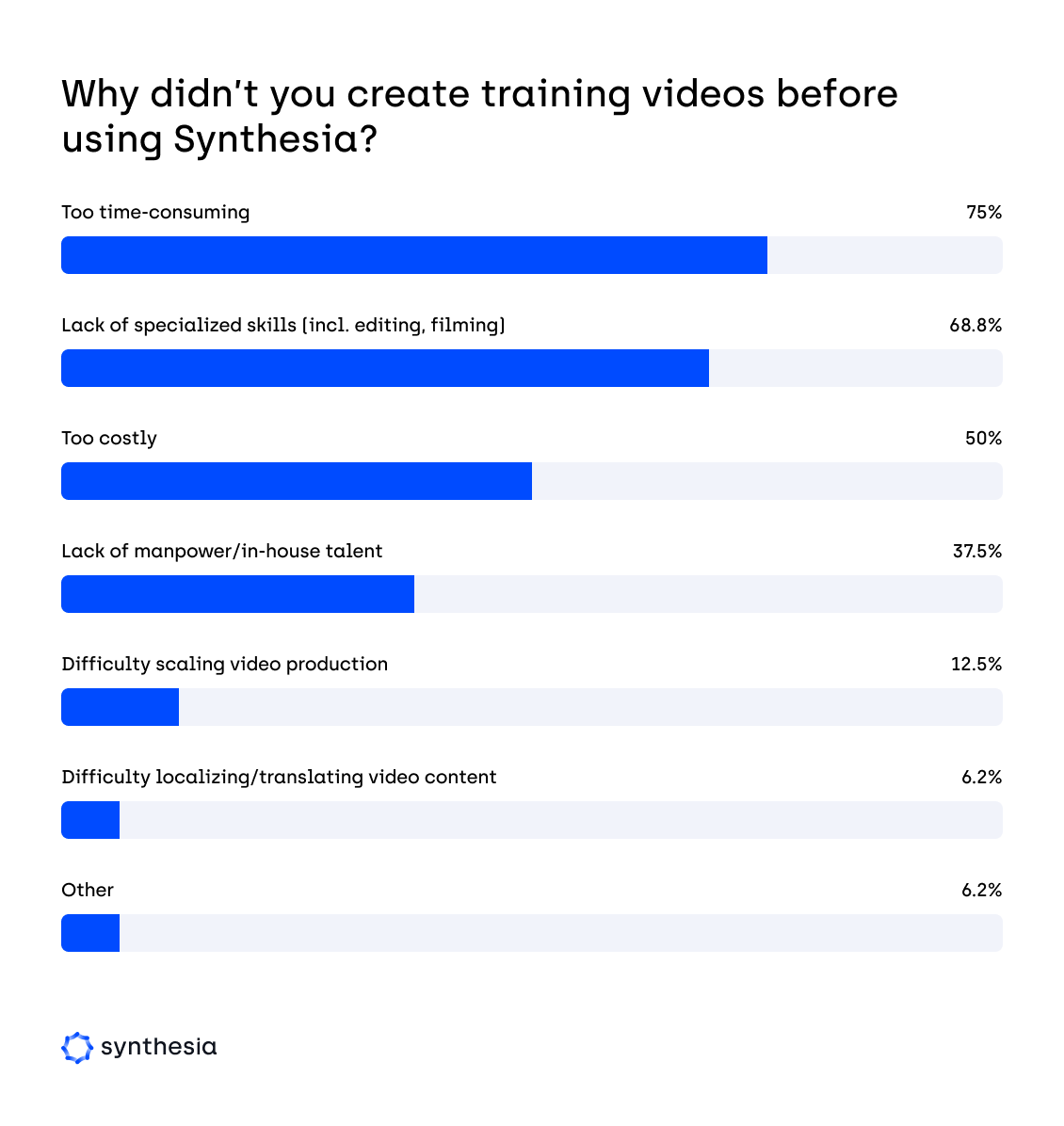
Stat 7: The top 3 most time-consuming aspects of traditional video production in L&D are: editing, filming/creation, scriptwriting.
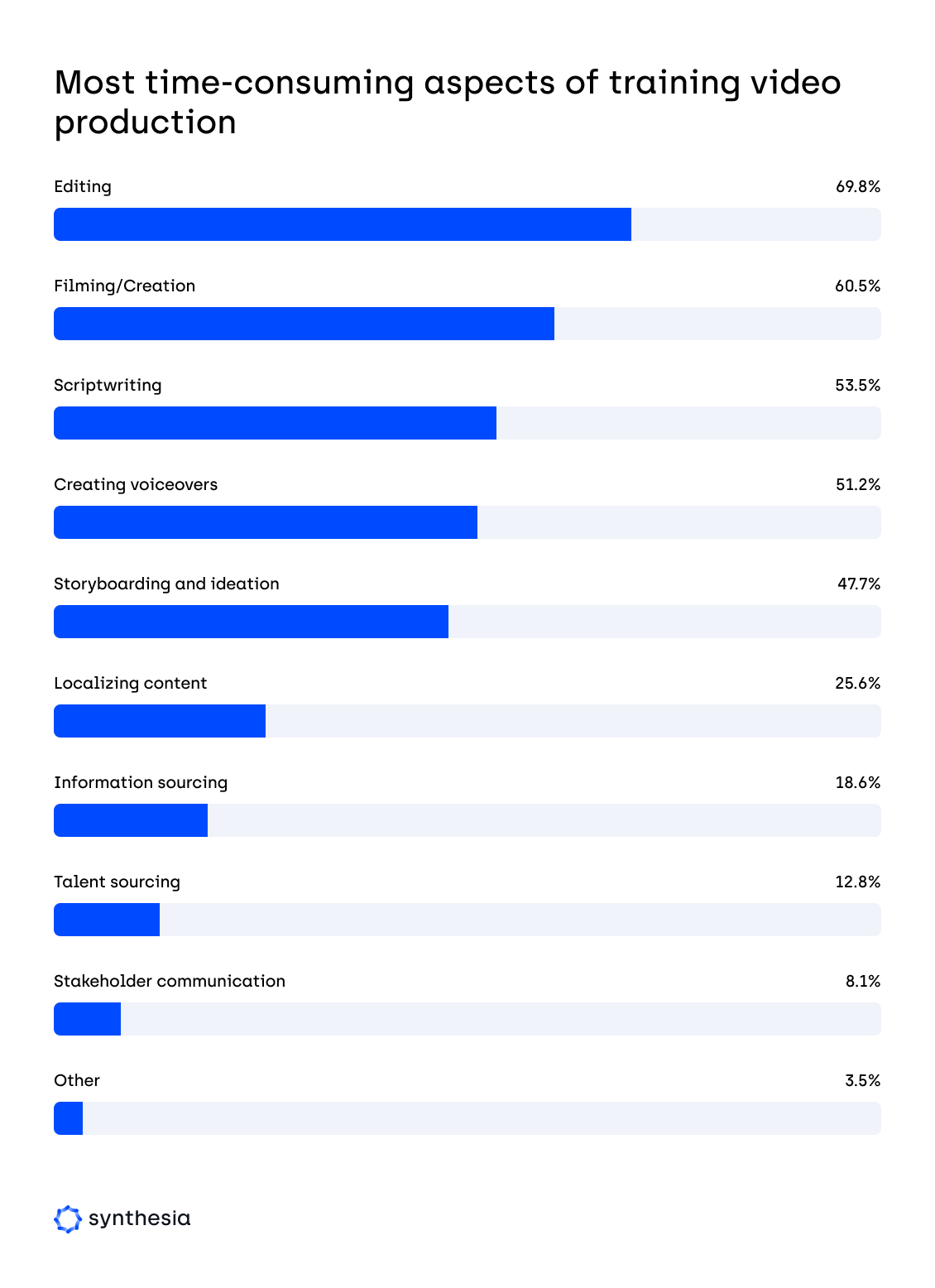
Stat 8: The top 3 biggest obstacles for producing video content for L&D in 2023 are: time, updating/re-recording content, ensuring videos are engaging.
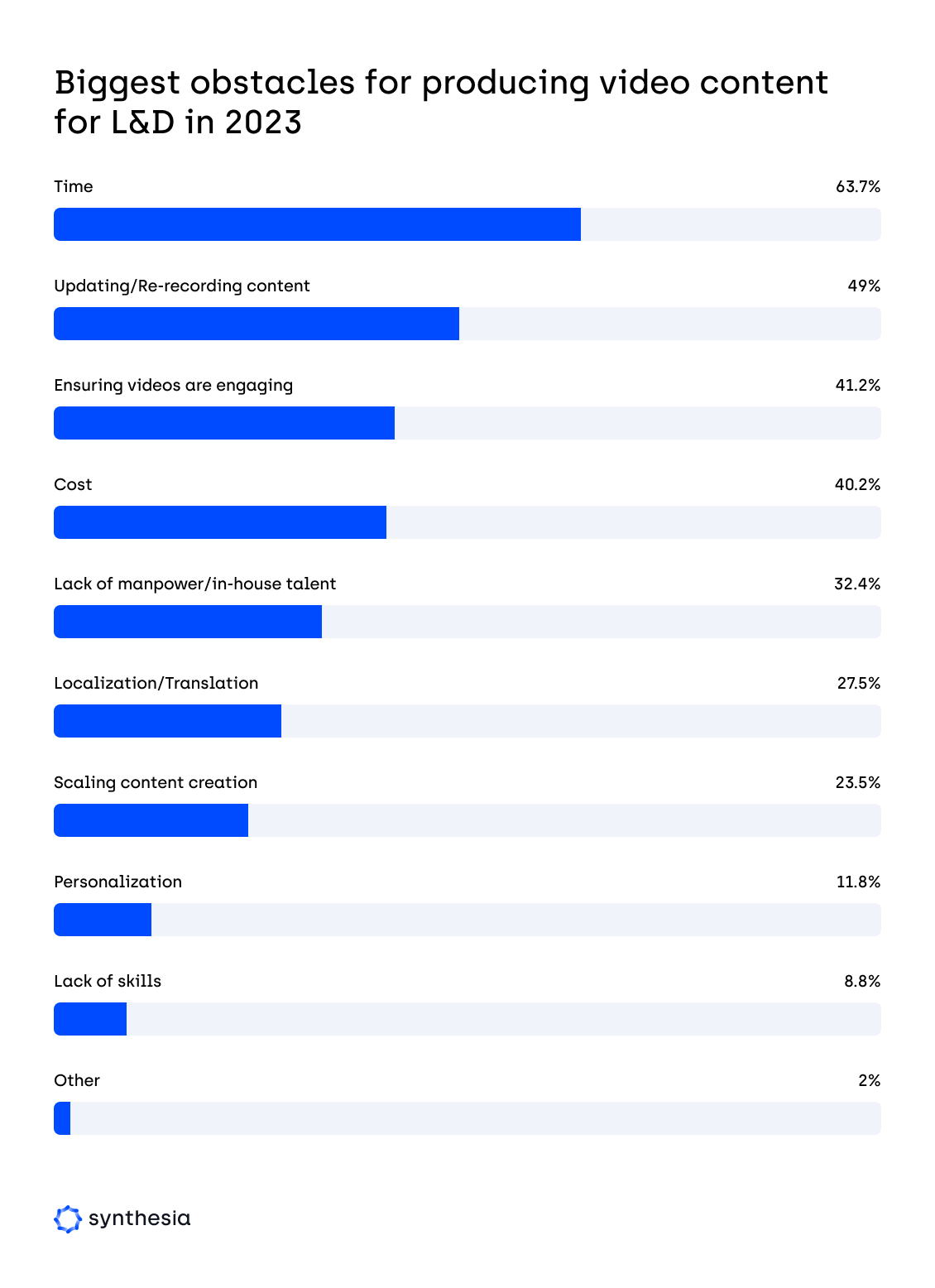
Stat 9: The 4 primary benefits of using AI tools in video production are: reduced production time, reduced production cost, ease of updating content and ease of localization.

Beyond numbers: what do the experts think?
Ease of updating is the master key that opens many new doors for potential video delivery. Every video that was accurate when it was made but slow to be updated (if it ever is updated) does damage by delivering misinformation or mistrust. This creates drag that the next video project must then overcome. - Sam Rogers, Principal Consultant
I’m surprised and saddened that people are still seeing time, costs, and skills as a barrier to creating video content because there are so many free and low-friction tools at our disposal. - Gary Stringer, Senior Content Marketing Manager
Traditional video production vs AI
Most respondents have created videos the traditional way before turning to AI video production, so let’s take a look at how the two compare. What are the key benefits of using AI and how much time does it save?
Stat 10: Before AI video, an employee spent an average of 45 hours per month producing training videos. With Synthesia, they can save up to 34% of this time.

Stat 11: After using AI, the average training video length was reduced by 1.2 minutes, which is a 12% decrease.
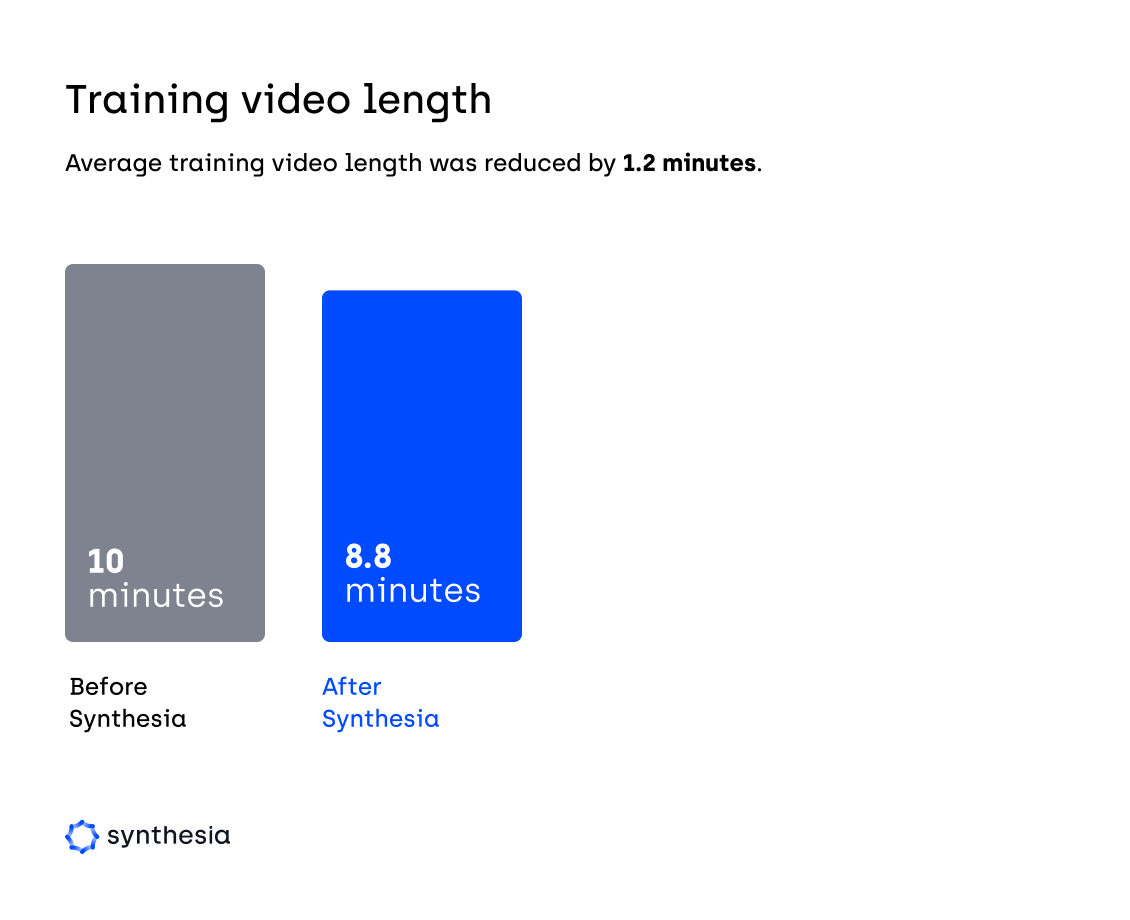
Stat 12: Training video production time decreased from 13 days to 5 days on average since using AI, which is a 62% decrease.
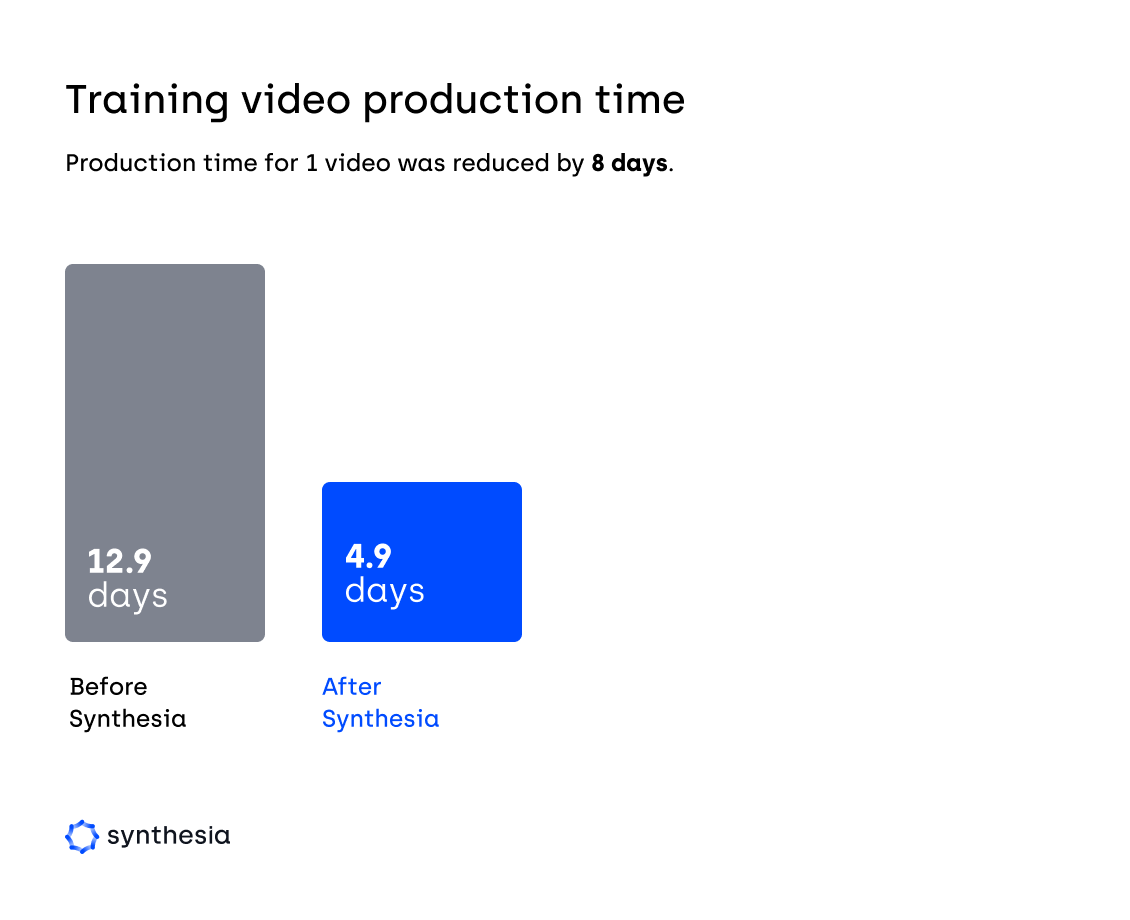
Stat 13: 43% of respondents claim AI tools have replaced traditional video production processes in their organization.
Stat 14: The top 3 parts of video production that have been fully or partially replaced by AI are: voiceover actors, self-recording (video&audio), video production companies.

Beyond numbers: what do the experts think?
Wow… that video production time saved figure is impressive. That’s a massive amount of savings. If the average L&D salary is $50 USD per hour - that’s 9K+ in savings per year. That adds up! - Josh Cavalier, Learning Architect
One the biggest aspect I am looking AI to improve is the editing aspect. Typically this involves heavy processing so PCs are more expensive and bigger and time to understand all the different plug-ins and features that you need to master to be confident in making your own video. Using a tool that simplifies all that is important. We can then focus on the story rather than the edit. - Toby Newman, Senior L&D Consultant
The big benefit I see here is the reduction in average video length. …by making videos 12% shorter on average, you’re not making them 12% less relevant, you’re making them 12% tighter by reducing extraneous material. - Sam Rogers, Principal Consultant
The effectiveness of video in L&D
Video is undoubtedly an attractive format for training, appealing to both students and L&D professionals. But how do we know it’s actually doing its job? Find more about the effectiveness of (AI) video in this section!
Stat 15: 97% of respondents find video effective in helping employees retain information they get in training.

Stat 16: 97% of L&D professionals find video more effective than text-based documents.
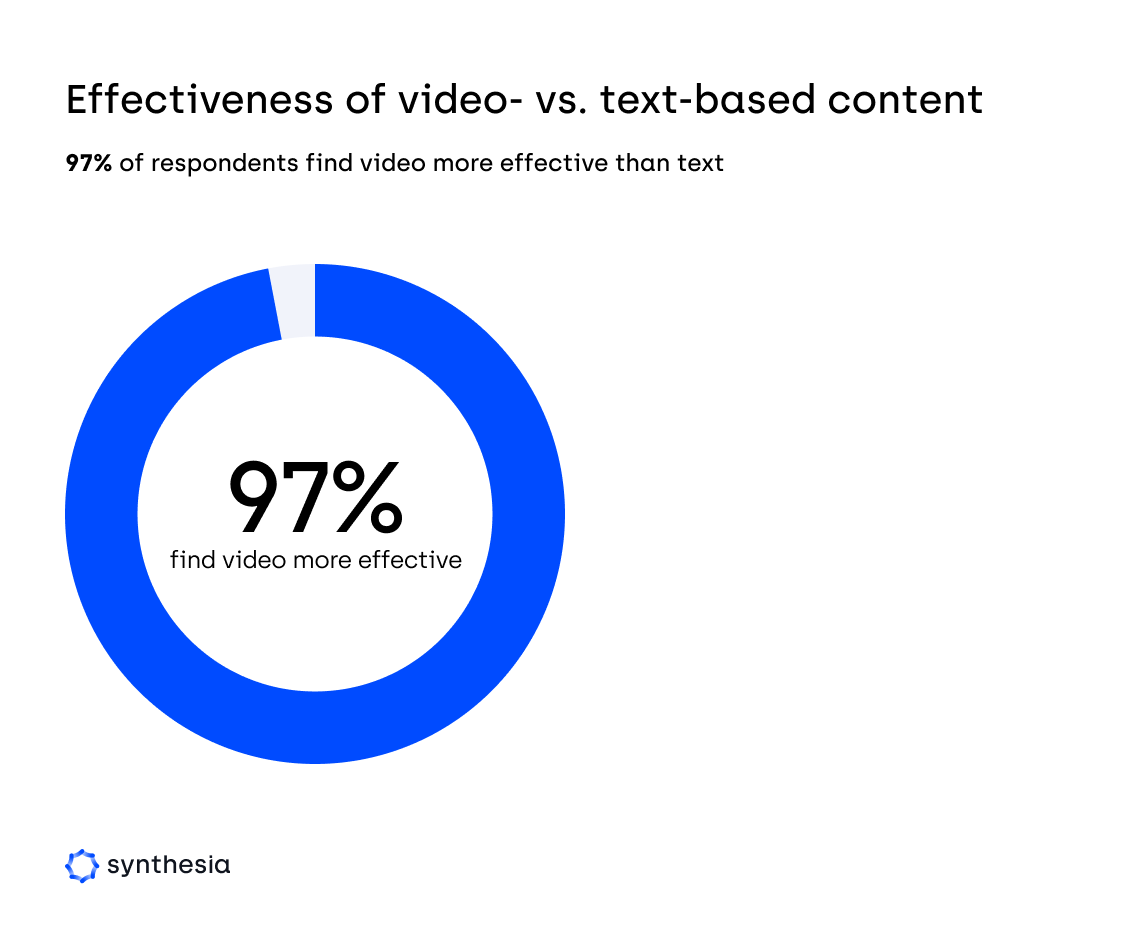
Stat 17: Most popular metrics used to measure the success of video-based training: learning satisfaction scores, course completion rate, average time to completion.

Stat 18: 57% of respondents have seen a positive impact on the completion rates of training courses with the use of AI video.
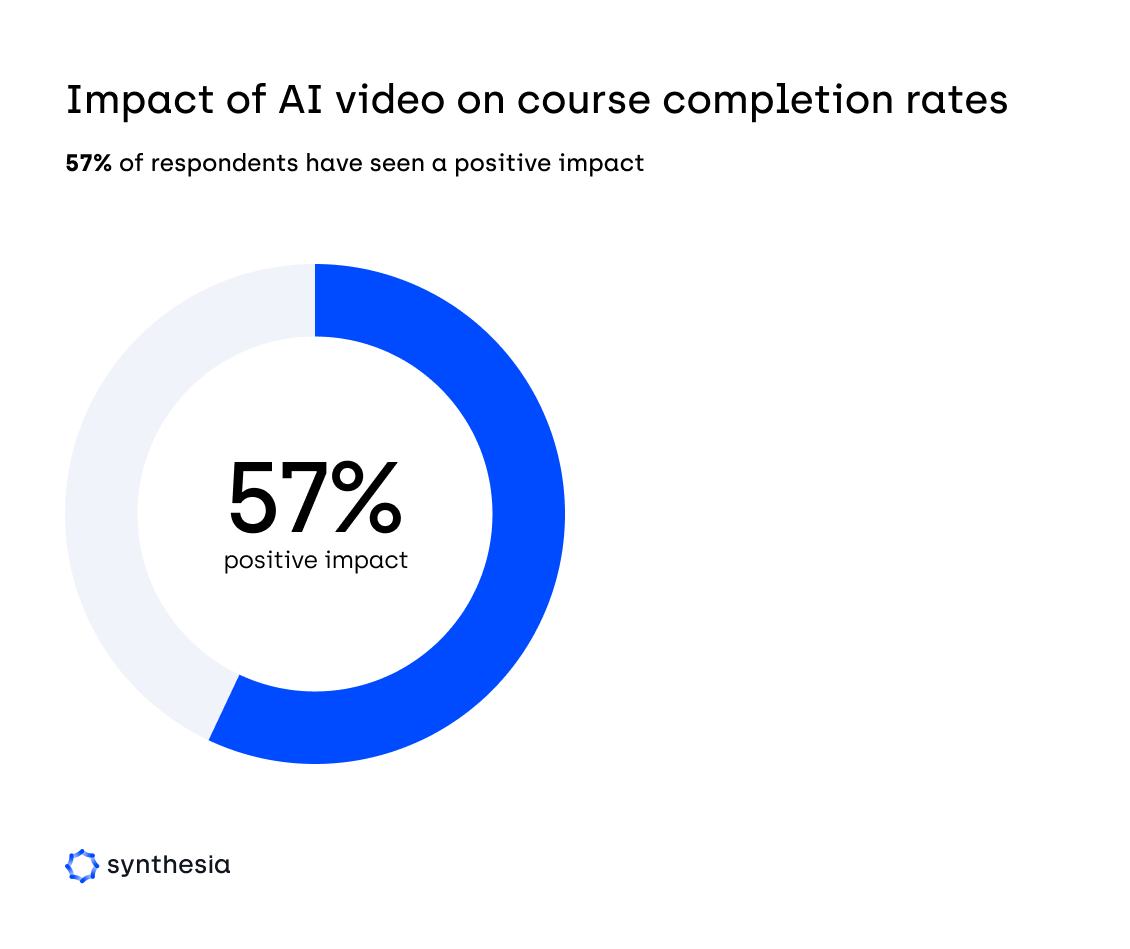
Stat 19: 60% of respondents have seen a positive impact on the average time to completion of training courses with the use of AI video.
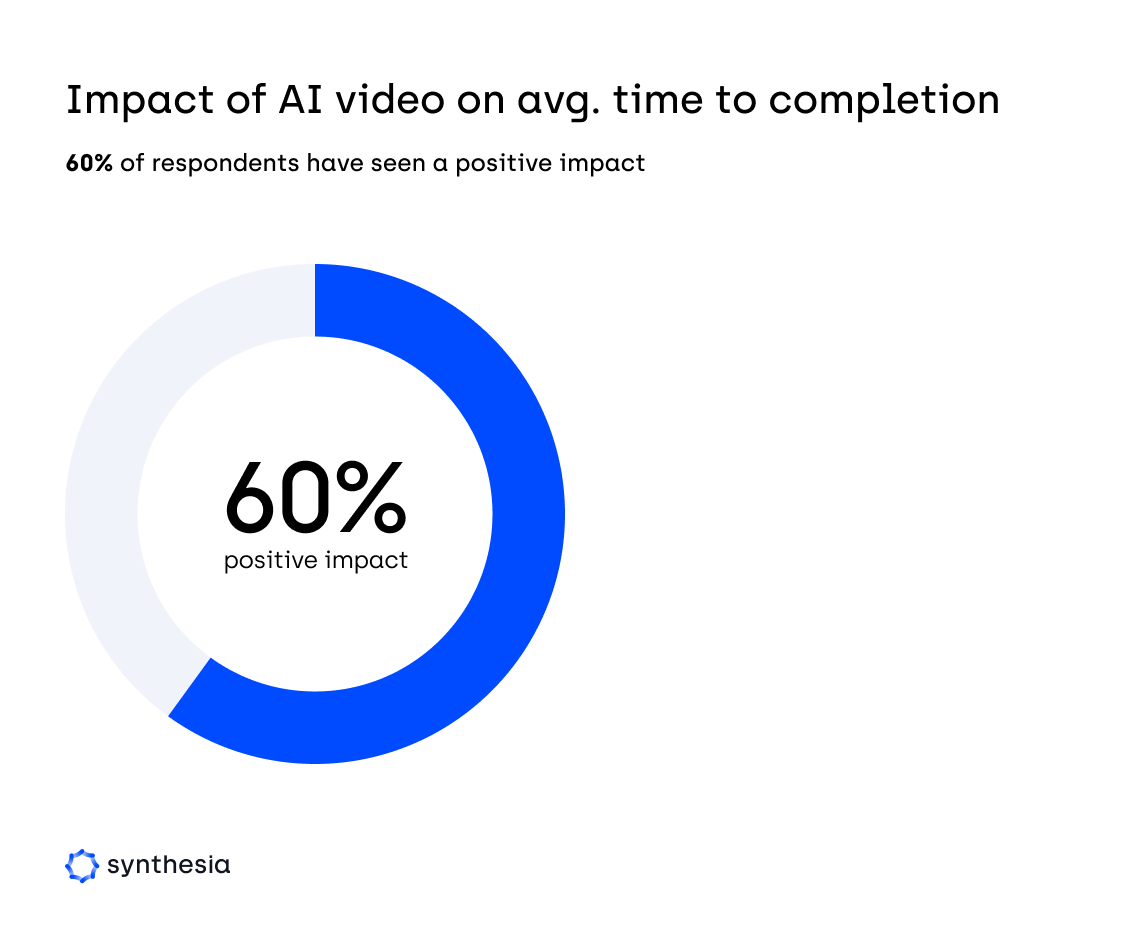
Stat 20: 68% of respondents have seen a positive impact on the learning satisfaction scores of training courses with the use of AI video.
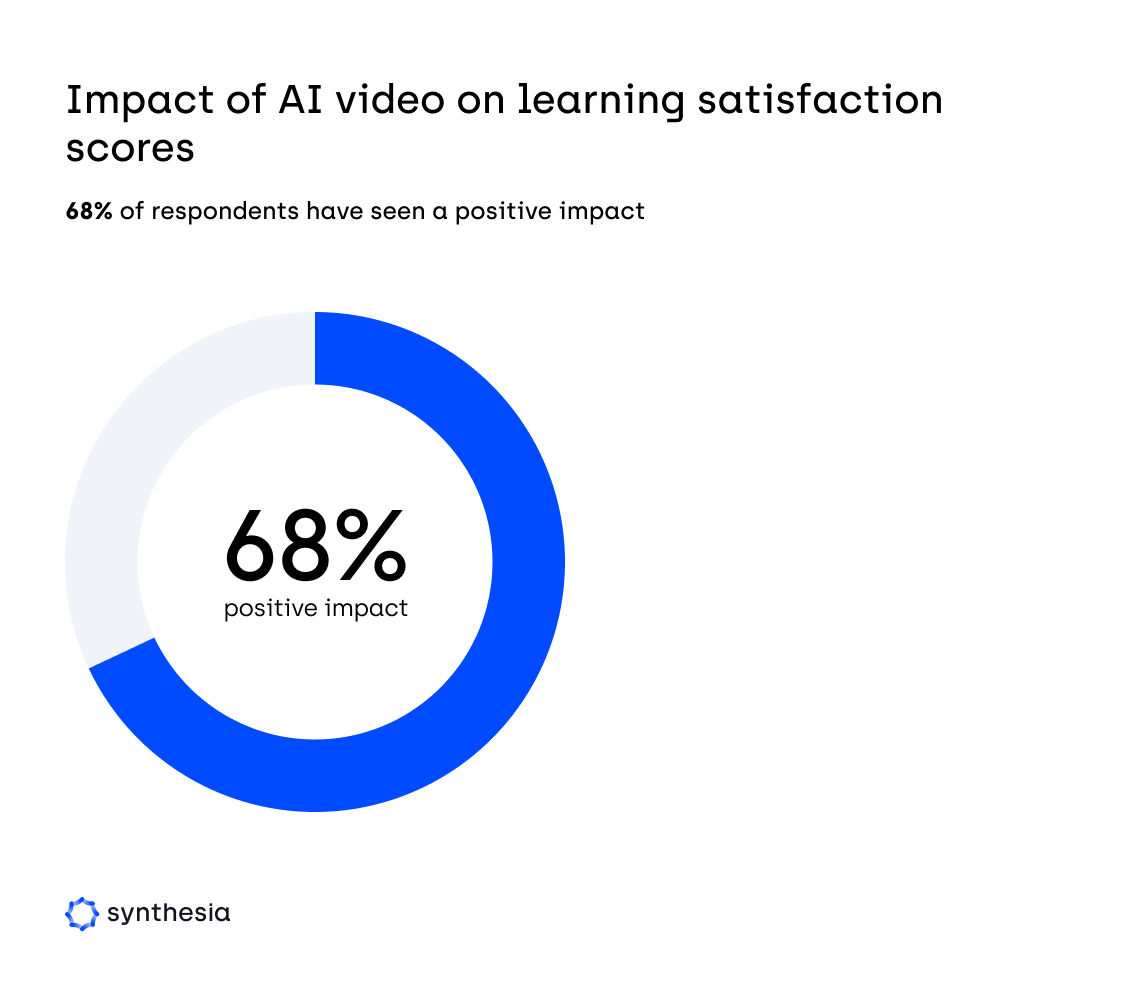
Beyond numbers: what do the experts think?
I think one of the nice things about video over other formats is that you can track it. If I send you a PDF, I don’t know how much you have read it. And while you could say that you could just hit play a video and go off and do something else, I still believe that you will get ‘second-hand’ learning - just the same as you could listen to audio as you fall asleep. - Toby Newman, Senior L&D Consultant
We all know how to watch a video, and we tend to have more pleasant associations with this activity than with reading books, taking online courses, or going to classes. It’s not surprising that we feel video is more effective, finish videos more often, and generally like them better! - Sam Rogers, Principal Consultant
97 pc! That’s quite impressive. I’m thinking this is mostly high-quality video, served up in a contextual and personalized way and where the entire target audience has no problems accessing it. In short, great video content delivered in optimal conditions. - Ajay Jacob, L&D Manager
The future of AI video in L&D
The data shared in this report indicates that AI video is becoming increasingly important in the L&D space. The insights shared by Synthesia users show that video is a valuable tool for training, but that creating high-quality videos can be challenging.
However, AI video solutions are proving to be a game-changer, making video production faster, more cost-effective, and more accessible. As L&D experts seek to improve their training programs and keep pace with the latest trends, AI video is definitely worth exploring.
Here you learn more about how AI can revolutionize video creation in the L&D space.
About this report
Our aims and objectives
After the initial excitement surrounding AI in 2023, it has become clear that this technology will shape the future of content production. Among its many potential applications, AI has already made impressive progress in revolutionizing video production in the L&D space. We conducted this survey to gain in-depth insights into the role of video in training, identify existing challenges, and determine whether AI-generated video can alleviate these issues.
Our method
We surveyed 102 Synthesia users in the L&D space. The majority of them work in companies with more than 1000 employees across various industries including software, healthcare, consulting, and education, among others. The survey covered participants from different regions around the world including Europe, North America, Asia, Africa, and Australia.
About Synthesia
Synthesia is the leading AI text-to-video generation platform, focusing on AI video for L&D teams. Companies like Teleperformance, Ocado, BSH, and others use it to scale their training video production while saving up to 80% of their resources. Learn more here →
The contributors
A huge thank you to the L&D professionals who generously shared their invaluable expertise in this post. Your contributions have been instrumental in providing a practical and insightful interpretation of the results.
- Jeannette Readbad, L&D Head at Coca-Cola Beverages Philippines
- Gary Stringer, Senior Content Marketing Manager at HowNow
- Sam Rogers, Principal Consultant at Snap Synapse
- Josh Cavalier, Learning Architect at ATD
- Toby Newman, Senior L&D Consultant at C.H. Robinson
- Ajay Jacob, L&D Manager at TomTom
About the author
Strategic Advisor
Kevin Alster
Kevin Alster is a Strategic Advisor at Synthesia, where he helps global enterprises apply generative AI to improve learning, communication, and organizational performance. His work focuses on translating emerging technology into practical business solutions that scale.He brings over a decade of experience in education, learning design, and media innovation, having developed enterprise programs for organizations such as General Assembly, The School of The New York Times, and Sotheby’s Institute of Art. Kevin combines creative thinking with structured problem-solving to help companies build the capabilities they need to adapt and grow.

You might also like
Frequently asked questions
How effective are training videos?
According to a survey conducted by Synthesia, 97% of respondents find video effective in helping employees retain information they get in training.
How much more effective is video content?
According to a Synthesia survey, 97% of L&D professionals find videomore effective than text-based documents.
















